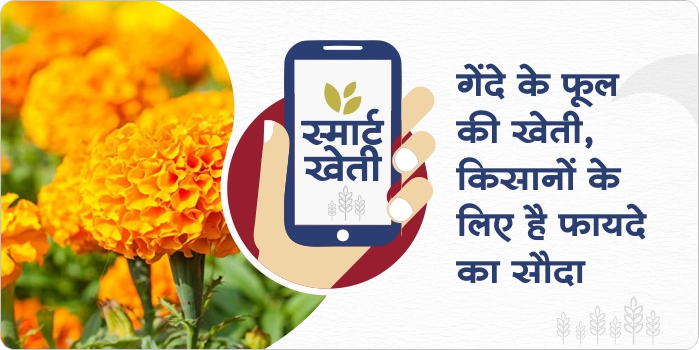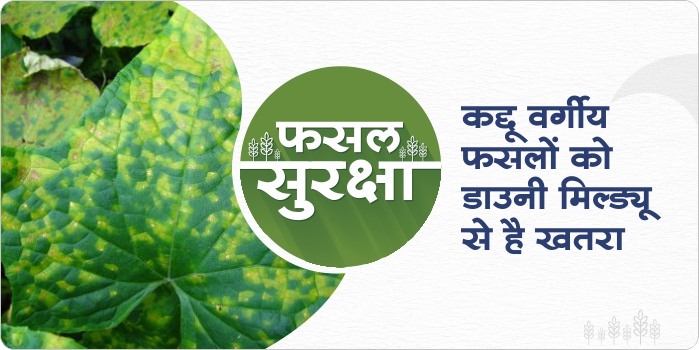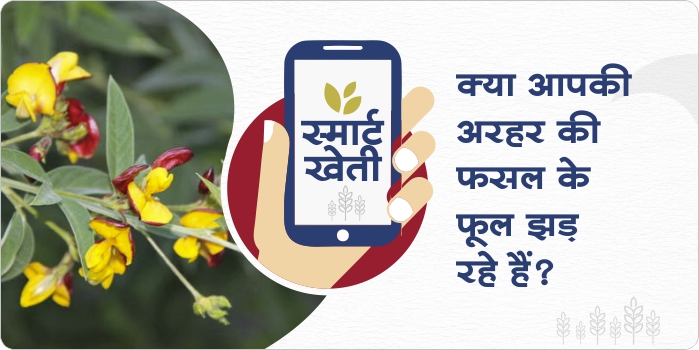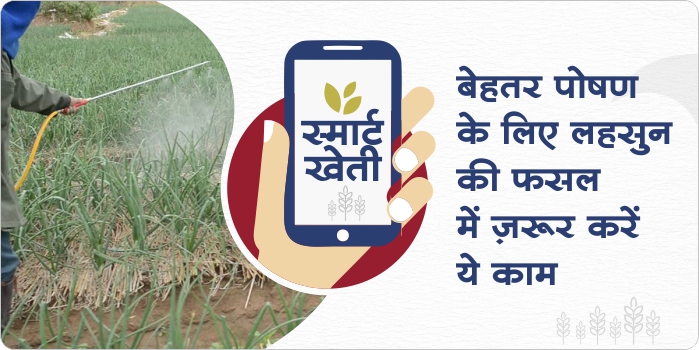- Marigold crop has become a very popular crop due to it being a low-cost short duration crop.
- As it’s easy to farm, it is being widely adopted. Marigold is found in two different colors, orange and yellow, it has two varieties (of different color and shape) – African marigold and French marigold.
- Marigold is cultivated in almost every region. It is the most important flower crop. It is widely used in religious and social works.
- Marigold is also cultivated to obtain carotene pigment which is used for the yellow color in various foods.
- The oil obtained from marigold flowers is used in making perfumes and other cosmetics. It also has medicinal properties.
- It is also grown as a defense shield between crops to reduce pest infestation in crops.
Identification and control of Downy Mildew in Cucurbitaceae crops
- In Cucurbitaceous crops, the effect of this disease causes gray spots on the lower surface of the leaves.
- Pale yellow spots are formed on the upper surface. This disease causes more damage to cucumber, gourds, and melons.
- Along with this, on the leaves, a layer of brownish-black color is formed. If it rains in the summer season, this disease becomes very common.
- For the control of this disease, Metalaxyl 4% + Mancozeb 64% WP @ 600 gram / acre or Sulfur 80% WDG @ 500 gram / acre or Tebuconazole 10% + Sulfur 65% WG @ 500 gram / acre
- Spray Trichoderma viride @ 500 gram / acre or Pseudomonas fluorescens @ 250 gram as a biological treatment
2000 rupees given in bank accounts of 5 lakh farmers of Madhya Pradesh
On the lines of Pradhan Mantri Kisan Samman Nidhi Yojana, some state governments have also made plans to provide financial assistance to farmers. The Madhya Pradesh government has also started a similar scheme called “Chief Minister Kisan Kalyan Yojana” and under this scheme, 4000 rupees will be given in 2 installments to the beneficiary farmer families of PM Kisan Samman Nidhi Yojana.
The Chief Minister of Madhya Pradesh, Shri Shivraj Singh Chouhan, on November 2, sent a total of Rs 100 crore to 5 lakh farmers, leaving 19 districts having by-elections in the state under this scheme. Explain that this is the first installment of 2000 rupees given to farmer families under this scheme.
Source: Kisan Samadhan
ShareCrop Management in Pigeonpea at Flowering Stage
- This is an important time for pigeon pea farmers as this is the time of flower emergence.
- In such a situation, farmers can get good yield with a little bit of effort. In the time of flowering, light irrigation should be done in the pigeon pea.
- Also one of the reasons for the flower drop in pigeon pea is the attack of thrips, which is very important to control on time.
- Simultaneously, if a stressful situation arises in the pigeon pea crop, spray homobrassinolide @ 100 ml/acre to prevent it.
- For control of thrips use Fipronil 5% SC @ 400 ml / acre or lambda cyhalothrin 4.9% CS @ 200 ml / acre or fipronil 40% + imidacloprid 40% WG @ 40 gram / acre or thiamanthoxam 12.6% + lambda cyhalothrin 9.5% ZC @ 80 ml / acre or spinoseed at 45% SC @ 60 ml / acre.
- Spray Beauveria Bassiana @ 250 gram/acre as biological treatment.
How to use Gram samridhi Kit
- Gramophone exclusive gram samridhi kit is used as a soil treatment.
- The total volume of this kit is 4.5 kg which is enough for one acre.
- It can be used along with urea, DAP, or Potash with 50 kg of well-decomposed cow dung, or compost or dry soil.
- It is necessary to have sufficient moisture in the field at the time of its use.
- If you were not able to use this kit at the time of sowing, then it can be used as broadcasting in 15-20 days of sowing.
Gramophone app is increasing farmers’ income by 40%
Since its inception in 2016, so far more than five lakh farmers have joined Gramophone and there have been many positive improvements in their agriculture. Under the guidance of gramophone agricultural experts, there has been a good increase in the income of thousands of farmers. The average income of many farmers is increasing by up to 40%.
Farmer Poonam Chand Sisodia of Khandwa district connected his soybean crop to the Gramophone app at the time of sowing and he got all the necessary advice over the phone. This resulted in a 60% increase in yield. Apart from this, the cost of agriculture also decreased.
Sagar Singh Solanki, also from Khandwa district, reduced his agricultural costs by 21% and increased income by 25% using the gramophone app. Their total profit increased by 37% compared to the earlier.
One such farmer is Vinod Gujjar, resident of Dewas district, for whom Gramophone’s Moong Samriddhi Kit proved like a boon. The yield of the crop sown on 5 acres increased from the earlier 25 quintals to 30 quintals using the kit. With the increase in yield, there was an increase of 38% in income and 100% in profit.
Gramophone’s Soya Samriddhi Kit provided so much good nutrition to the soybean crop of Ramnivas Parmar, another farmer from Dewas, that the profit from the crop increased by 180% in advance and the quality of the yield from the crop was so good that its value in the market Found more than other farmers’ produce.
Like these farmers, lakhs of farmers are taking advantage of Gramophone’s high services and increasing their income as well as reducing their agricultural costs. In just four years, Gramophone has started to achieve the goal set by itself. In the days to come, Gramophone has joined the farmers of the entire country and has set the goal of modern agriculture for Indian agriculture and Indian farmers.
ShareHow to manage garlic crop in 15 days
- Garlic crop is a tuber crop, due to this it is very important to manage nutrition and diseases in garlic crops.
- Crop management can be done to protect the crop from fungal diseases such as root rot, stem rot yellowing, etc. for this spray Carbendazim 12% + Mancozeb 63% @ 300 gram / acre or Hexaconazole 5% SC @ 400 ml / acre.
- To protect garlic crops from sucking pests, spray the Acetate 75% SP @ 300 gram / acre or Bavaria Basiana @ 250 gram / acre as a biological treatment.
- For a uniform growth and good root growth of garlic crop, use Urea @ 25 kg / acre + zinc Sulphate @ 5 kg / acre + Sulfur 90% @ 10 kg / acre broadcast in soil in 15 days of sowing
How to manage nutrition at the time of sowing in wheat
- Wheat is the main crop of the rabi season. Nutrition management at the time of the sowing of wheat gives it a good start.
- Growth of roots is good and tillers emerge very well.
- At this time, the following products should be used to manage nutrition
- Use Urea @ 50 kg / acre + DAP @ 20 kg / acre + MOP @ 25 kg / acre
- Urea is the source of nitrogen, DAP is a source of nitrogen and phosphorus, and MOP supplies the necessary potash, thus the production can be increased by managing nutrition after sowing in the crop of wheat.
Spray and nutrition and management in 15 days of onion transplanting
- Nutrition management and spray management in 15 days of transplanting of onion is very important for good production.
- With the proper nutrient management, nutrients are properly used by the onion plants and the roots of the onion crop spread well in the ground also developing immunity against diseases.
- Urea @ 30 kg / acre + sulfur 90% @ 10 kg / acre should be mixed with soil and broadcast in the field before sowing.
- Urea is a source of nitrogen as well as sulfur. It plays a very important role in prevention of fungal diseases as well as in nutrient supply.
- For insect control, spray Fipronil @ 5% SC @ 400 ml / acre.
- Spray Humic acid @ 100 gram / acre for good root growth, spread well in the ground.
- For fungal diseases spray Carbendazim 12% + Mancozeb 63% @ 300 gram / acre or Thiophanate Methyl 70% W/W@ 300 gram / acre.
With Gramophone, in just 1.5 years, the annual income of the farmer increased to 25 lakhs
Since the start of Gramophone in the year 2016, since then more than 5 lakh farmers have been associated with Gramophone and this association is also increasing the prosperity of the farmers. One of this prosperous farmer is Shekhar Pemaji Chaudhary, a resident of village Pipri under Bhikangaon tehsil of Khargone district.
A year and a half ago, when Team Gramophone met Shekhar Pemaji Chaudhary, he showed the green fields of his bitter gourd and told that he got his farm soil tested on the advice of Gramophone, and with this, he earned about 8 lakhs from the bitter gourd crop. Nearly one and a half years after this initial success, Shekhar has become a prosperous farmer and has proved to be a role model for other farmers around him.
Recently, when the Team Gramophone once again came to meet Shekhar, he told a very inspiring story behind his prosperity. He told how in the last year and a half, he cultivated in his six acres of fields with the help of his hard work and the advice of Gramophone and earned 25 lakhs annually. He also said that with this income, he built a house of 16 lakhs and bought a car of 8 lakhs. Explain that in the total income of Shekhar ji 25 lakh, the agricultural expenditure of about 12 lakh comes and they get 13 lakh profit every year.
This story of Shekhar ji is an inspiration for all the farmers. Other farmers can also join Gramophone like Shekhar ji. To connect with Gramophone, you can either miss call on toll-free number 18003157566 or login to the Gramophone Krishi Mitra app.toll free
Share









